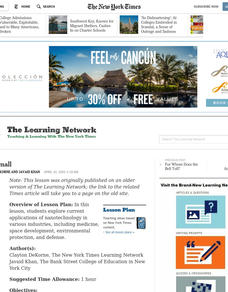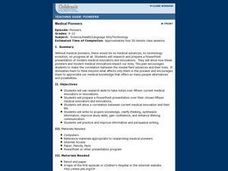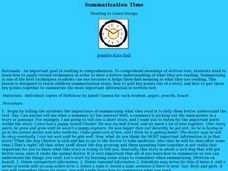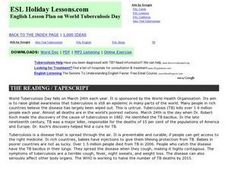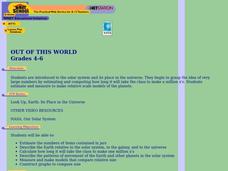Curated OER
Think Small
Learners explore current applications of nanotechnology in various industries, including medicine, space development, environmental protection, and defense.
Curated OER
Medical Pioneers
Students use research skills to take notes over fifteen current medical innovators or innovations. They prepare a PowerPoint presentation over their chosen fifteen medical innovators and innovations. Students show a correlation between...
Curated OER
That's Dope - Part 1
Students investigate drugs in sports. In this performance enhancing drugs lesson, students discuss the uses for steroids in medicine and sports. Students utilize the web to play a steroid related game, view media clips of their favorite...
Curated OER
Making Cookies- How many per hour?
Fifth graders measure how long it takes to make cookies. In this measuring time lesson, 5th graders explore how to manage time. Students decide when to start making breakfast on time, how to calculate playing time into their lunch time,...
Curated OER
Medicine Show
Pupils gather anecdotal evidence about various herbal remedies' abilities to cure ailments, develop hypotheses from these observations, and design scientifically valid experiments that could prove their suppositions.
Baylor College
Needs of Living Things: Pre-Assessment
Determine your class's prior knowledge about the necessities of life with this pre-assessment for a unit on living things. Learners draw pictures of themselves with all the things they need to live, grow, and survive. These drawings will...
BioEd Online
Spiders in Space
Does a spider spin its web differently in space? What other ways might microgravity affect an arachnid? Pick a topic to research, plan an investigation, and follow astronauts on the International Space Station as they perform some of the...
BioEd Online
Good Stress for Your Body
Stress the importance of the different types of pressure our mind and body experience in a lesson about how certain types of stress are actually necessary and good for our bodies. As astronauts and people with injuries can attest, not...
Curated OER
Phineas Gage: “This I Believe” Venn Diagrams After Reading Strategy
Difficulties with brain injuries still continue today. After reading Phineas Gage: A Gruesome but True Story About Brain Science, class members read a series of modern personal essays about brain injuries and choose an essay to compare...
National Institute of Open Schooling
Nomenclature and General Principles
Carbon, the base for all organic compounds, exists in nature in its purest form as graphite or diamonds. The 25th lesson in a series of 36 teaches pupils the nomenclature of organic compounds. Learners read about how to use the IUPAC...
Curated OER
Summarization Time
Students write summaries in this lesson. They read "Stellaluna" by Jaell Cannon independently and answer story map questions: who, what, when, where, and why. They then take the answers to these questions and write an individual summary.
Curated OER
Health Grade 1
First graders determine the difference between good and bad drugs. In this instructional activity about drug awareness, 1st graders explore differences between drugs. Students will look at picture and understand what uses there are for...
Curated OER
Under The Doctors Advice
Students discuss the importance of specifically following medical instructions. They simulate a conversation between a pharmasist and a patient. Students compare and contrast medical and natural remedies. This lesson is intended for...
Curated OER
The Witch of Goingsnake
Students listen to The Ballad of Ira Hayes and write paragraphs about his character. In this The Witch of Goingsnake lesson, students read the verses and chorus of the ballad aloud and make notes about Ira Hayes. Students write a...
Curated OER
World Tuberculosis Day
March 24th is annually recognized as World Tuberculosis Day. In this World Tuberculosis Day worksheet, students complete activities such as word scramble, numbering passages, scrambled sentences, think=pair-share, and peer interviewing....
Curated OER
Are We Taking Drugs that are Safe?
Students compare ideas and make a value judgment about medications and their reliability.
Curated OER
Where will "Brave Irene" take us today?
The pupils listen to and discuss the book "Brave Irene." The students then participating in creating a class web about a snowstorm. The pupils then independently journal about bravery. They conclude the instructional activity by creating...
Curated OER
Language Arts: The Doctor Will See You Now
Students are able to compare the treatments available for certain medical conditions during three different points in time during the last hundred years; list the medicines and drug therapies available now that have helped them and those...
Curated OER
Genetic Engineering
Students discuss the risks and benefits associated with biotechnology. In this biotechnology activity, students discuss the role of genes in the body and brainstorm ethical issues relating to biotechnology. They read about an ethical...
Curated OER
Enrichment Activities - "Mrs. Frisby and the Rats of NIMH"
Fifth graders read the novel "Mrs. Frisby and the Rats of NIMH." They discuss the various characters in the book, and the different types of conflict that take place within the book. They also research owls and rats to make comparisons...
Curated OER
Out of This World
Pupils are introduced to the solar system and its place in the universe. They begin to grasp the idea of very large numbers by estimating and computing how long it take the class to make a million x's.
Curated OER
Growth and Changes in Plants
Students investigate the growth and changes in plants. They view a video and discuss the changes in plants. They work in small groups to demonstrate vocabulary words to the class. They visit a green house and take pictures of plants to...
Curated OER
Worm Interviews
Students identify types of worms. In this organisms lesson, students are shown slides of the different types of worms and take notes on each worm. Students answer questions about each worm.
Curated OER
The Human Body: Focusing on Respiratory and Circulatory Systems
Students study the components and functions of the respiratory and circulatory systems. They take blood pressure using a stethoscope and investigate ways to maintain a healthy respiratory system.
